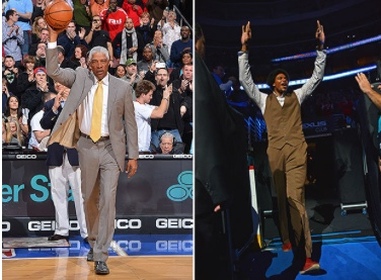 GREAT Article concerning why ANYONE (not just athletes) gets injured or are in PAIN! The following article is written and provided by colleague Tim George, Clinic Director at Egoscue-San Diego South. Are Some Athletes Injury Prone? Absolutely there are some athletes that are injury prone, but it can definitely be corrected. It is true that some athletes are prone to injuries, but the issue can be resolved with proper therapy. The picture above shows two basketball players. The gentleman on the left is Julius "Dr. J" Erving , one of the greatest basketball players of all time. He played for over 15 years scoring over 30,000 points, and was rarely injured. The gentleman on the right is Andrew Bynum. He is an up-and-coming player who at times is one of the best centers in the NBA, but knee injuries have hindered his progress. Bynum's knee injuries might be blamed on bad luck, bad work ethic, or just bad genes. However, I think Bynum's injury woes are a result of postural imbalances, specifically his valgus knees. 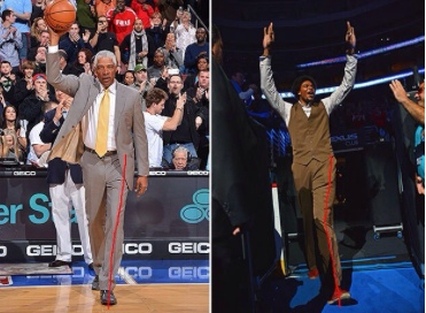 Take a closer look at the above picture, specifically the left leg of both gentlemen. Do you notice any differences? Bynum's left knee is valgus, or knocked kneed. This occurs when the adductor muscles (inner thigh) and rotational leg muscles compensate for the main posture and gait muscles (the ones that should flex and extend the hips, knees, and legs). When Bynum walks or runs the left knee visibly tracks to the inside and the foot turns out, pivoting on the heel, and rolls inward. This leads to a lot of instability when he walks or runs, and means that any unstable surface could spell disaster for his knee. On the other hand, you can see how straight the line is on Dr. J's leg- a great example of a knee in proper alignment. In my opinion this posture kept Dr. J out of the therapy room and on the court playing basketball.
How do these differences occur? In my opinion Bynum's valgus knee position is nothing more than the product of growing up in a motion-starved environment. Dr. J grew up during a different generation where the environment was motion-enriched. For example, Dr. J had to stand up and walk to change the channel on the television, whereas Bynum can stay seated and change the channel remotely. The example may seem trivial, but the cumulative effects of the body in motion contributed to Dr. J maintaining a functional and balanced body, and led to the success of his basketball game. Some may argue the fact that Bynum is a professional athlete and he gets plenty of motion....right? He probably spent countless hours in the gym working on his basketball game, but also think about the time he spent riding in cars, sitting in front of the television, or at desks in classrooms. Bynum's life (like many people today) lacks the movement that provides function and balance to the body. Consequently, he steps onto the basketball court with a body and posture that lacks the proper musculoskeletal functions to keep himself injury free. This scenario is not an isolated issue for Andrew Bynum- the rate of injury for athletes in all sports of all levels is on the rise. The reason for this increase is that more and more athletes play their sport with postural dysfunctions that predispose them to injuries. What athletes need to focus on is a pre/post exercise routine that will align their joints into a stable position both before and after they have exerted themselves on the playing field. If done regularly this will no doubt keep the athlete on the field and injury free, and it should also result in a better overall performance. _______________________________________________________________Life is short. Living with numerous or slowly increasing limitations due to pain and dysfunction is not really living. Change can not happen if all things stay the same. No one can truly heal your body except you. External forces, gadgets (shoes), pills, surgery, manipulations are just addressing symptoms and not the root cause. We are happy to help people use their natural healing ability to make the necessary changes without special shoes, pills, manipulation or surgery. Catee Ingwersen is a Posture Alignment Specialist trained, certified by the Egoscue University in The Egoscue® Method. She empowers people every day to overcome pain and physical limitations unlike any other healing or medical intervention. Call 772-559-1532 or stop by our Clinic in Vero Beach, Florida to discuss this common sense approach and your individual needs.
0 Comments
Do you have heel pain, corns, ingrown toenails, hammer toes, plantar fasciitis, bunions, numbness, crossed toes? Biologically, your body is designed to have and keep muscle tension balanced to allow the major joints to remain optimally functional which keeps the skeletal in proper healthy position to live a long active life without limitations. If muscle tension and muscle length are modified over time, bones will be pulled or pushed in detrimental positions. Some joints will become too tight and restrict movement, some too loose not providing enough stability. Sometimes a combo of each: one side of the limb, joint or body is too tight and the other side too loose which makes the bones move "wonky" at angles and in ways they weren't meant to. This causes dysfunctional joint and structural wear and tear and pain. Arthritis and other maladies will develop and structural, muscular, pain and problems will surface. Another way to seriously compromise your health is by making a habit of wearing shoes that will deform the feet. As you may have read on this website, a problem in one area of the body WILL create problems in the other areas of the body. Our body parts are inextricably interdependent on each other. Here are 3 Main Problems with most SHOES today: 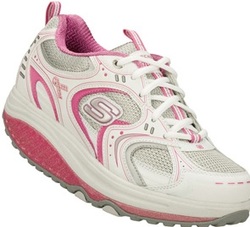 1. Heel elevation When your shoe heel or "wedge" is higher than (2:1 ratio or more) the height of the forefoot of the shoe (under the ball of the foot), this extends the bones of the toes and toe joints and changes the angle of the ankle. The foot is now jacked up and can no longer distribute weight across the base of the whole foot. This puts the majority of weight in the bones of the forefoot (the metatarsals) and toes. This causes a myriad of painful problems for the foot and toes. 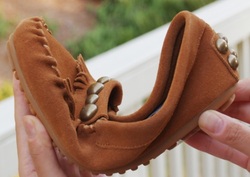 2. Toe Spring The toes, forefoot and ankle are designed to bend and straighten to allow for freedom of movement and for open communication with the brain about the terrain. A rigid sole or inflexible platform prevents the foot's natural rolling motion which shortens the muscles (extensors) on top of the foot and over lengthens (flexor) muscles on foot bottom. Rigid shoes shut down the neurological communication feedback loop to the brain about the terrain. Your shoes should allow you to bend it in half and to twist it in a wringing fashion. That is how much movement your foot should have and your shoes should allow. Feet that are in immoveable shoes will become immoveable too. A braced encased joint, joints or foot is a dying one. 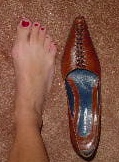 Photo from Dr. Jonathan Cluett Photo from Dr. Jonathan Cluett 3. Toe Box Widest part of the foot is the toes or toes "box." Put your bare foot on top of a plain piece of paper. Draw around the outline of your bare foot on the paper. Now compare the width of your foot drawn on the paper with the width of the shoes you own. The outline of your actual foot shows how your shoes should be shaped. Cramming your feet into too narrow or too short or or ill-fitting shoes is creating disturbances in the function of the muscles of your foot. Since our bodies function as an entire unit and not parts in isolation of one another, the ankles, knees, hips and pelvis and possibly shoulders can be negatively impacted as well--all because of the shoes you wear. Your body is designed to have a specific "gait". Shoes that impede your body's natural movement patterns will create muscle imbalances, tension and problems elsewhere in your body. 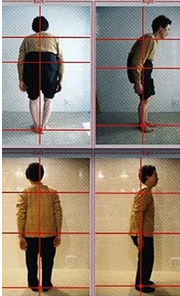 Although shoes can have a dramatic impact on your feet, ankles and gait, that is not all that may be creating pain in your feet, ankles and toes. If your muscles which surround and operate joints and bones are not doing their jobs properly and completely, your limbs and joints won't move properly. If you do have muscle imbalances in your body this can wreak havoc on all other areas and joints and even organ systems over time. Proper shoes are critical but they won't necessarily fix a dysfunctional hip or knee or shoulder or spine. Muscles move Bones. Muscles can move bones out of their proper position over time. Muscles can be reprogrammed to move bones BACK into their proper position with the Correct Stimulus. It doesn't matter who in your family had or has what you have. It doesn't matter your age. What matters is your muscles have forgotten some of their jobs over time due to injuries or habitual patterns of movement or non-movement. Many of our clients have been very successful returning their bodies to the functional status they once had and getting themselves out of pain naturally without "state of the art" shoes, gizmos, surgery or drugs. Corrective foot surgery, corrective shoes, orthotics, special running shoes that correct for supination or pronation are merely providing a crutch for your feet, ankles and body. Once the crutches are removed the underlying problem is still there. Don't sweep your pain and physical problems under the rug. Come in for an evaluation. We know you (like many others) will be astounded at what you will discover about your body's position, movement patterns and muscle imbalances. Call today: 772-559-1532
Catee Ingwersen is a Posture Alignment Specialist trained, certified by the Egoscue University in The Egoscue® Method. She empowers people every day to overcome pain and physical limitations unlike any other healing or medical intervention. Call 772-559-1532 or stop by our Clinic in Vero Beach, Florida to discuss this common sense approach and your individual needs. |
AuthorCatee Ingwersen is an Egoscue certified Posture Alignment Specialist and Licensed Massage Therapist. Archives
June 2018
Categories
All
|
 RSS Feed
RSS Feed